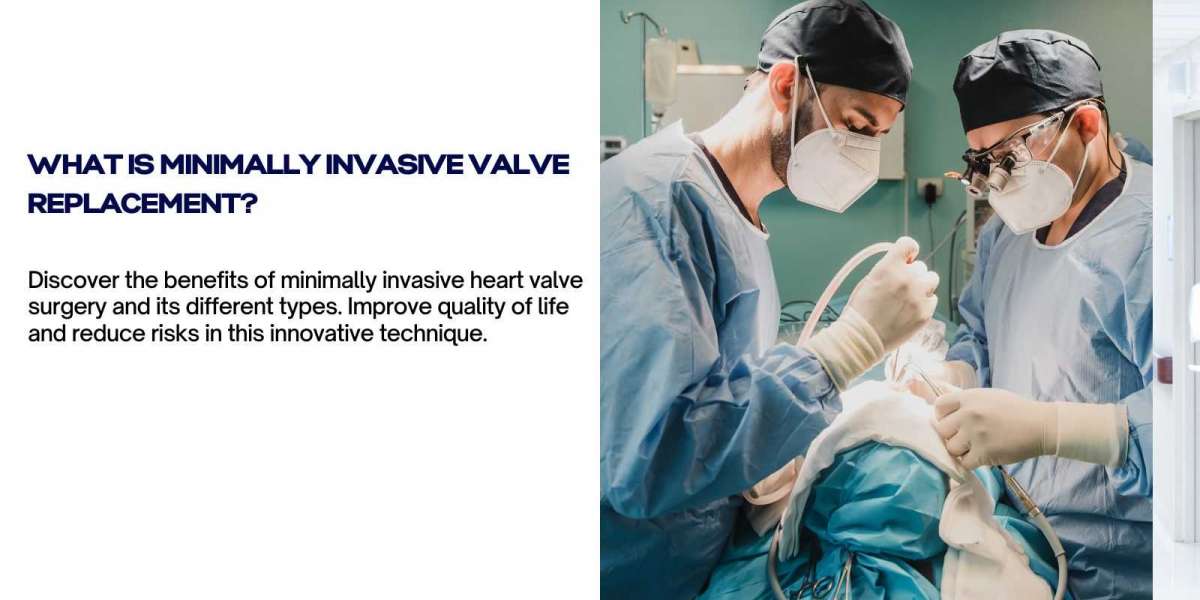In the dynamic realm of medical advancements, minimally invasive valve replacement has emerged as a transformative procedure in cardiac surgery. Unlike traditional open-heart surgery, this innovative approach minimizes the impact on the patient's body, resulting in reduced recovery times and lower risks of complications.
Introduction
Definition of Minimally Invasive Valve Replacement
Minimally invasive valve replacement is a surgical procedure aimed at correcting heart valve issues with a focus on minimizing trauma to the patient's body. This approach uses advanced surgical techniques and technologies to achieve the necessary corrections with smaller incisions compared to traditional open-heart surgery.
Importance of Minimally Invasive Procedures in Medical Advancements
The rise of minimally invasive procedures marks a significant milestone in the field of medicine. As technology continues to progress, these procedures offer patients alternative options that are less invasive, allowing for faster recovery and improved overall experiences.
Types of Valve Replacement
Traditional Open-Heart Surgery
Traditional open-heart surgery has long been the standard for valve replacement. This invasive approach involves a large incision, often splitting the breastbone, to access the heart directly.
Minimally Invasive Valve Replacement
Key Differences
Minimally invasive valve replacement differs significantly from traditional methods. The procedure involves smaller incisions, usually between the ribs, and employs specialized instruments and advanced imaging technologies to guide the surgeon.
Advantages Over Traditional Surgery
The advantages of minimally invasive valve replacement are manifold. Patients typically experience reduced pain, shorter hospital stays, and quicker return to normal activities compared to those undergoing traditional open-heart surgery.
Procedure Details
Access Points in Minimally Invasive Valve Replacement
During minimally invasive valve replacement, surgeons access the heart through small incisions between the patient's ribs. This approach eliminates the need to split the breastbone, resulting in less postoperative pain and a lower risk of infection.
Role of Advanced Imaging Technologies
Advanced imaging technologies, such as 3D echocardiography and robotic-assisted systems, play a crucial role in guiding surgeons during the procedure. These technologies enhance precision, allowing for accurate placement of the new valve.
Surgical Techniques Used in the Procedure
Surgeons employ various techniques in minimally invasive valve replacement, including video-assisted thoracoscopic surgery (VATS) and robot-assisted surgery. These approaches provide a detailed view of the surgical site and enable precise movements for optimal outcomes.
Benefits of Minimally Invasive Valve Replacement
Reduced Recovery Time
One of the primary benefits of minimally invasive valve replacement is the significantly reduced recovery time. Patients often experience a quicker return to normal activities and experience less postoperative discomfort.
Lower Risk of Complications
Compared to traditional open-heart surgery, minimally invasive procedures carry a lower risk of complications such as infections and excessive bleeding. The smaller incisions contribute to a more straightforward recovery process.
Enhanced Patient Satisfaction
Patients who undergo minimally invasive valve replacement frequently report higher satisfaction levels. The combination of reduced pain, shorter hospital stays, and quicker recovery enhances the overall patient experience.
Candidates for Minimally Invasive Valve Replacement
Patient Criteria
While minimally invasive valve replacement is a viable option for many patients, not everyone is a suitable candidate. Factors such as the type and severity of the valve issue, overall health, and medical history play a crucial role in determining candidacy.
Considerations for Medical History and Conditions
Surgeons carefully assess a patient's medical history and existing conditions before recommending minimally invasive valve replacement. Certain factors, such as previous heart surgeries or complex valve issues, may influence the decision to opt for traditional open-heart surgery.
Success Rates and Statistics
Comparative Data with Traditional Valve Replacement
Studies consistently demonstrate favorable outcomes for minimally invasive valve replacement compared to traditional methods. Lower mortality rates, reduced complications, and improved quality of life contribute to the procedure's success.
Long-Term Outcomes and Patient Experiences
Patients who undergo minimally invasive valve replacement often enjoy long-term success with their new valves. The positive impact on quality of life, coupled with the procedural benefits, highlights the significance of this innovative approach.
Surgeon's Perspective
Training Requirements for Minimally Invasive Procedures
As minimally invasive procedures become more prevalent, surgeons undergo specialized training to master these techniques. This training ensures that medical professionals can proficiently perform minimally invasive valve replacement, providing patients with expert care.
Advancements in Surgical Technology
Technological advancements continue to enhance the field of minimally invasive surgery. From robotic-assisted systems to improved imaging techniques, these innovations contribute to the success and widespread adoption of minimally invasive valve replacement.
Patient Testimonials
Real-Life Stories of Individuals Who Underwent the Procedure
John's Journey to a Healthier Heart
John, a 58-year-old patient, shares his experience with minimally invasive valve replacement. "The recovery was so much quicker than I expected. I was back to my regular activities within a few weeks, and the minimal scarring was a bonus. "
Sarah's Transformation
Sarah, diagnosed with aortic valve disease, opted for minimally invasive surgery. "I was hesitant at first, but the smaller incisions and faster recovery exceeded my expectations. I feel healthier and more energetic now."
Challenges and Limitations
Potential Complications
While minimally invasive valve replacement offers numerous benefits, potential complications exist. These may include bleeding, infection, or the need for additional procedures in some cases. Surgeons thoroughly discuss these risks with patients during the preoperative consultation.
Instances Where Traditional Surgery Might be Preferred
In certain complex cases, traditional open-heart surgery may be the preferred option. Surgeons carefully evaluate each patient to determine the most suitable approach based on individual circumstances.
Future Trends in Minimally Invasive Valve Replacement
Ongoing Research and Technological Innovations
Researchers continually explore ways to refine and improve minimally invasive valve replacement. Ongoing studies focus on enhancing surgical techniques, developing new materials for prosthetic valves, and expanding the applicability of these procedures.
Potential Improvements and Broader Applications
The future holds promise for further improvements in minimally invasive valve replacement. As technology advances, the procedure may become more accessible to a broader range of patients, offering a minimally invasive option for various cardiac conditions.
Conclusion
In conclusion, minimally invasive valve replacement represents a paradigm shift in cardiac surgery. With its numerous benefits, from reduced recovery time to lower risks of complications, this innovative approach is reshaping the landscape of cardiac care.
Source:- https://www.micsheart.com/minimally-invasive-heart-valve-surgery/








